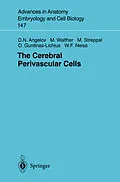Following an exhaustive literature review on the global issue of intracerebral presentation of antigen, this monograph summarizes results from voluminous work to establish which indigenous cerebral cells might present (auto)antigen to the immune system and thus initiate an (auto)immune reaction. Employing the combination of (a) a lesion model in which neuronal degeneration and neuronophagia are caused without disruption of the blood--brain barrier, (b) stable labeling of the neuronophages via phagocytosis of the permanent nontoxic fluorescent marker Fluoro-Gold from preloaded neurons, and (c) immunocytochemical identification of all FG-labeled brain neuronophages, the authors provide evidence that the only cells in the rat CNS which can be regarded as the resident antigen presenting cells of the brain are perivascular cells.
Inhalt
1 Introduction.- 1.1 Antigen Presentation and Antigen Presenting Cells.- 1.2 Antigen Presentation within the CNS.- 1.3 Microglia Might Be the Cerebral Antigen Presenting Cells.- 1.4 Theories on the Antigen Presentation Site.- 1.5 Questions Still Open.- 1.6 Methodological Approach.- 2 Materials and Methods.- 2.1 Animals.- 2.2 Overview of Animal Experiments.- 2.3 Surgery.- 2.4 Number of Sprouting Neurons After Retrograde Tracing with HRP.- 2.5 Number of Surviving Neurons After Resection of the Facial Nerve.- 2.6 Neuronophagic Microglia Identified by Vital Labeling with Fluoro-Gold.- 3 Results.- 3.1 Resection of 10 mm of the Facial Nerve Causes a Slow Loss of Facial Motoneurons in the Adult Rat.- 3.1.1 Comparison of Axonal Sprouting After Transection and Resection of the Facial Nerve as Revealed by Retrograde Tracing with Horseradish Peroxidase.- 3.1.2 Comparison of Neuron Numbers in the Facial Nucleus After Transection and Resection of the Facial Nerve as Revealed by Immunocytochemistry with Anti-NSE.- 3.2 No Breakdown of the Blood - Brain Barrier or Passage of Unprimed Lymphocytes into Brain Tissue After Facial Nerve Resection.- 3.2.1 Intact Blood - Brain Barrier to HRP After Resection of the Facial Nerve.- 3.2.2 No Entry of Lymphocytes into the Brain Tissue After Resection of the Facial Nerve.- 3.2.3 No Immunopositive Cells for "Lymphocyte-Recognizing" Antibodies Observed in the Lesioned Facial Nucleus.- 3.3 Fluoro-Gold Labeling of Motoneurons, Phagocytic Microglia and Perivascular Cells.- 3.3.1 Injection of Fluoro-Gold 29 into the Whiskerpad Muscles.- 3.3.2 Intravenous Injection of Fluoro-Gold.- 3.3.3 Intracerebroventricular Injection of Fluoro-Gold.- 3.4 Time Course of Existence and Migration of Fluoro-Gold-Labeled Neuronophages.- 3.4.1 Quantitative Estimates on the Neuronofugal Migration of Phagocytic Microglia as Identified by Fluoro-Gold.- 3.4.2 Migration of FG-Labeled Neuronophages.- 3.5 Immunocytochemistry of the Fluoro-Gold-Labeled Neuronophages.- 3.5.1 Bright-Field Immunohistochemistry.- 3.5.2 Combination of Immunohistochemistry with Fluoro-Gold Labeling.- 4 Discussion.- 4.1 Oligodendrocytes and Astrocytes Are Not the APC of the Brain.- 4.2 Microglia Are Not the APC of the Brain.- 4.2.1 Phagocytic Microglia Either Return to a Resting State or Die Due to Apoptosis.- 4.2.2 No Contact Between Phagocytic Microglia and Lymphocytes Beyond the Intact Blood - Brain Barrier of the Lesioned Facial Nucleus.- 4.2.3 Phagocytic Microglia Do Not Reach the Perivascular Space of the Brain.- 4.3 The Perivascular Cells Are the APC of the Brain.- 4.3.1 Sequential Immunoquenching Reveals That ED2-Positive Perivascular Cells Can Act as Neuronophages.- 5 Summary.- References.
